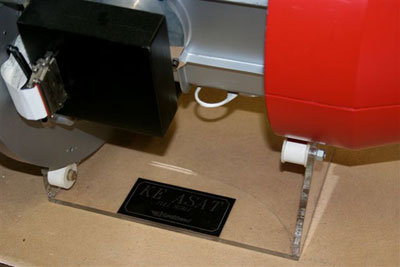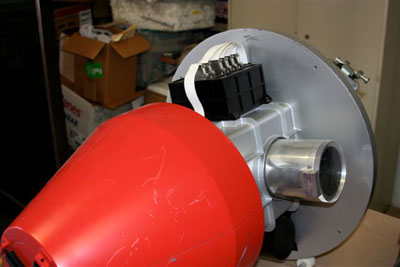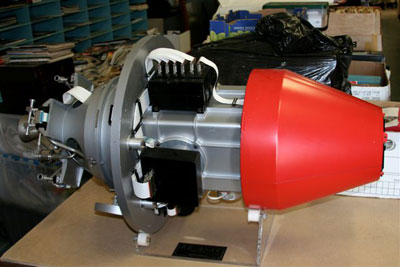Killer birdieby Dwayne A. Day
|
 Plaque on the model’s base. |
Whereas little is publicly known about the F-15 ASAT, relatively less is known about the KE-ASAT, not because of classification, but because nobody has devoted much attention to it. But sometimes, information surfaces even when nobody is looking. Proof of this can be found in the photos accompanying this article. During a recent visit I paid to the Aerospace Legacy Foundation’s offices located at the former North American Aviation Downey factory (now the home of Downey Studios), Dr. Jim Busby showed me something that threw me for a loop: a low fidelity mockup of a Lockheed KE-ASAT. Busby acquired it in the early 1990s, when its owner no longer wanted it.
The mockup is clearly labeled “KE-ASAT” on a plaque, but it is not the US Army KE-ASAT of the 1990s, which was not built by Lockheed. That weapon looks considerably different than this one. The Army KE-ASAT has a large infrared seeker nose and small thrusters located around the center of gravity of the vehicle. This one has a thruster in the rear and attitude control thrusters also located near the rear. A flat plane antenna, possibly a radar, is located to one side of the rear thruster and can swivel through an arc of approximately 45 degrees. But the mockup also has a large field of view sensor that looks out to one side, and a nosecone designed to open in four parts, although what it covers is unclear from the model. The mockup is slightly worn, but still completely intact. Busby also acquired a small model of the ring laser gyroscope that was designed to fit into the weapon.
So what is this thing?
 Wide field of view sensor located on the side of the KE-ASAT model. |
The most likely answer is that this is a model of Lockheed’s losing bid for the KE-ASAT program. Lockheed competed against McDonnell Douglas and Rockwell for the Army contract and lost to Rockwell in July 1990. Busby figures that he acquired the mockup around 1990 or so, although he’s not sure of the date. Normally one would expect a contractor to hold onto such a model for several years before disposing it. But Lockheed may have discarded it soon after losing the contract. Another, less likely, possibility is that the model dates from a few years earlier, perhaps the mid-to-late 1980s, and does not represent Lockheed’s losing bid for the KE-ASAT contract but merely a conceptual model.
 Rear of the KE-ASAT model showing the flat panel antenna at the rear that can slew back and forth. |
This does not shed much light on how the weapon was actually supposed to work, however. Why have a wide field of view sensor looking out to one side? Is that a star-tracker? And why have a radar antenna essentially pointing backwards? Why put the control thrusters at the rear of the vehicle when they should be located more centrally near the center of gravity? Finally, what the heck would be under the nosecone? Another sensor? A mylar flyswatter? The story on this model is still out, as is the story of much of the American ASAT program during the latter years of the Cold War and its aftermath.
